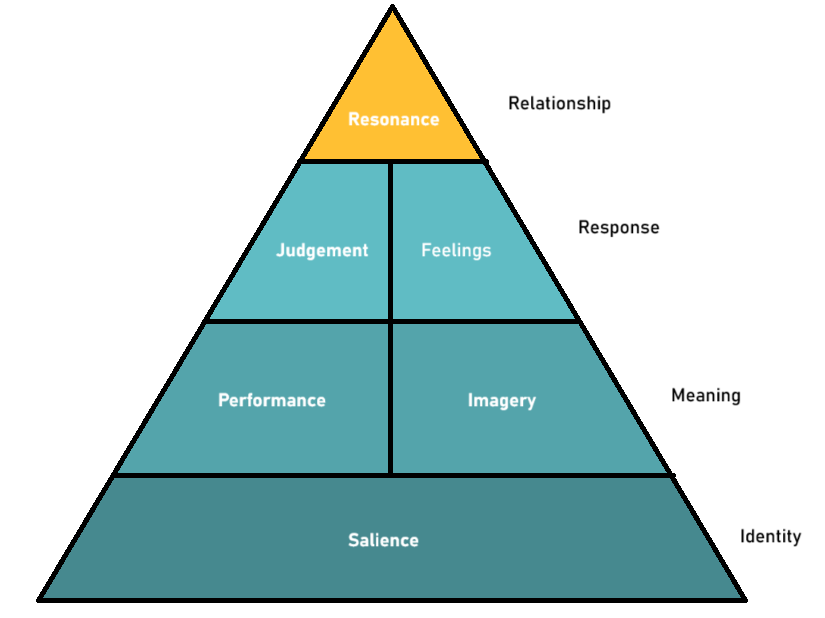
You know all about brand voice and brand identity. It doesn’t take a marketing or advertising expert to know that having a robust and well-known brand identity is crucial to driving sales, expanding reach, and overall letting a business grow and flourish. After all, customers trust what they know and like; that foundation is built on brand identity. But oftentimes, knowing a brand is just the beginning. Sure, a customer knows a brand, but do they relate to it? Do they actually trust it? Do they understand the brand and its messaging? In short, does the brand resonate with the customer? That’s where brand resonance comes in. Here, we’ll discuss brand resonance, its importance, and how creative advertising can help build it.
Think about your favorite brands, like a beloved coffee chain, shopping center, or even your favorite sports team. You know the brand’s name, its logo, and what it offers, but brand resonance asks you to think past that. How do you feel about it, and how does it enforce that feeling? Importantly, how do you think that brand feels about you in return? That is your relationship with the brand. Brand resonance does have an opposite, as well: brand dissonance. Think back to a brand or business you’ve sworn off, something you’ll never use, visit, or touch again if you can help it. Considering your least favorite brands isn’t quite as nice as mulling over your favorites, but it’s still important to understand how brands can resonate with us as consumers. Ultimately, it should represent a grand, non-tangible representation of your advertising and marketing campaigns and efforts, all working together to create an image of your brand in the minds of your core audience.
Using a handy pyramid is the best way to understand brand resonance. The pyramid concept was codified by Kevin Lane Keller’s Customer-Based Brand Equity (CBBE) model, outlined in 2001 and published by the Marketing Science Institute. It breaks brand recognition down into levels on a pyramid, with resonance taking a place at the top.

The base layer of this principle is identifying a brand: Who are they? When a customer hears about your brand online, in a television or radio ad, or even on a billboard, do they know, at a base level, who you are and what you do? If you see an advertisement for a worldwide brand like Coca-Cola, Apple, Disney, or McDonald’s, for instance, there’s a strong chance you already know what these brands do in a general sense, even if you’ve never engaged with them. This is because they’ve built up a significant brand identity. This doesn’t mean your brand has to become as iconic as Coca-Cola or Apple overnight, as even these big names didn’t get where they are now that fast, but building a recognizable brand identity with your customer base will help to lay the groundwork for overall brand resonance.
Meaning, the second layer, is bisected into two portions: brand imagery and brand performance. You can also think of this as rational and emotional schools of thought. Rationality, on the performance side, is where a customer makes up their mind about how your brand fulfilled their need. Did they get the product they expected, when and how they expected it, and were they satisfied with the price, reliability, or even visual aesthetics of a product or service? It is the concrete result of how consumers interact with and perceive the brand. Conversely, the imagery section refers to how they mentally and psychologically internalize a brand. Fonts, color schemes, and logo design come into play. How the website looks, for eCommerce, or how a store is lit, laid out, and presented for a physical, brick-and-mortar brand, will all tie into imagery. Don’t underestimate these aspects in building brand resonance.
The two portions in the section below will help influence the next layer: response. This layer of the brand resonance pyramid encapsulates the customer’s overall response to the messages a brand has created. When the rational judgments and emotional feelings meld together, they mentally foster a response.
Finally, we find brand resonance at the top of the pyramid, simplified as ‘relationship.’ After they’ve identified the brand, had a rational and emotional response to their experiences, and have responded to those reactions, the newly built relationship between the business and the consumer has been established. They know who you are, what goods or services you offer, and how they feel about it as a whole.
You want your customers to connect positively to your business and branding. That’s where brand resonance comes in. Brand trust is a top buying consideration. 46% of consumers say they would pay more for brands they trust, after all. It should go without saying that brand resonance is important. Once you’ve built a trusting relationship with your customers, they will likely engage with your brand again. It’s now up to them to determine how strong of a connection they want to have with a business - though, that’s not to say that creative advertising can’t help shape that relationship.
Creative advertising has immense potential to help build brand resonance. Through advertising media, businesses are given a mouthpiece to express their values, personality, and sales propositions. For example, if you are a furniture store, what sets you apart from other retailers in the same niche - or even big box ‘everything’ stores like Amazon or Target?
Slogans and creative storytelling through eye-catching visuals will help give a brand a personality. Great campaigns also help establish what a brand stands for, and what they sell, and can even represent what kind of experience a curious customer might anticipate when they engage. Not only does this cover the ‘identity’ section of this pyramid, but it can help bleed into imagery, and set up an expectation for performance.
Even the best-laid advertisements will be useless if they’re not put in front of the correct type of buyer. That’s why ad agencies usually go to the trouble of identifying and shaping a customer profile. For example, if someone who has never put a single drop of makeup on their face and has no plans to see an advertisement for an eyeshadow palette, there is only so much that ad alone can do to change their mind. Place that ad in front of a makeup artist’s YouTube video, in a fashion and style magazine, on a fashion-focused mobile app, or outdoors near a popular makeup retailer, and the brand is much more likely to resonate with its target audience.
When a consumer sees an ad, is prompted to engage with it and give their money to a business, and is shown exactly what they anticipated based on that advertisement - or even better than they bargained for - they will now step into the ‘response’ portion of the pyramid. They have learned that this brand delivers on its promises and lives up to the hype that a creative advertisement fosters. Advertising that is informational or educational, as well, can help build up credibility. Establishing oneself as a trustworthy, knowledgeable, and reliable expert helps establish brand resonance.
When a brand consistently shines a spotlight on its various offerings and benefits, consumers who might not have made a purchase in a while are reminded of their overall relationship with it. Solid, creative advertising encourages repeat customers. Additionally, continually living up to the promises of advertising and delivering a quality product will help a brand net that most valuable form of free advertising: word-of-mouth. It’s the most effective way to spread the word about a business, and the hardest to control.
Brand resonance is about shaping how a consumer interacts with a business. Through identity, emotional and rational reactions, and mental and physical brand responses, consumers build up the way that they ultimately feel about the products and services they engage with. Creative advertising is a crucial component of building brand resonance. If you’d like to get started with a media buying and planning agency with proven experience in building brand awareness and resonance, contact the team at Bloom Ads today. Through mobile advertising, print media, podcast advertising and more, we’ll help sow the seeds of brand resonance that will let your business bloom.